Acoustic-Fun PDM-10s Pocket DAC Review
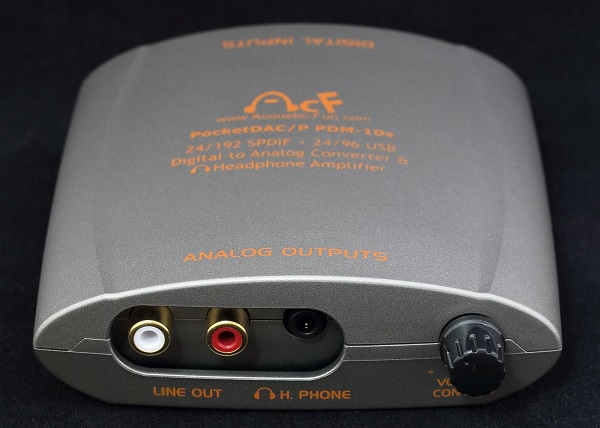
Acoustic-Fun is a Taiwanese brand that specialises in DIY parts, cables & DACs. The Acoustic-Fun (AF) PDM-10s is possibly the most compact DAC that includes all the essential bells and whistles that I was looking for. This DAC cost a total of USD 144 inclusive of shipping charges.
I wanted a portable, compact, functional and affordable DAC that would allow me to use my headphones with my Laptop, to listen to 16bit/48kHz and 24bit/96kHz FLACs, on the go. Over the last 05 years, there has been an explosion of budget DACs, especially USB DACs, in the market. This could be attributed to the change in the way people listen to music. Laptops, CPUs and HTPCs are finding their way as a source in many modern hi-fi setups. DAC technology is progressing so fast that we are now able to wring out more sound quality for the same or lesser amount of money when compared to DACs of yesteryears.
Setup & Performance
Much before the AF Pocket DAC’s arrival, I had used a measuring tape to gauge the size of this DAC. The AF Pocket DAC was not as compact as I had imagined. It’s not compact enough to fit my shirt pocket, however, it is compact enough to slip inside the side pocket of my Samsonite Laptop bag. It looks like a whisky flask lying on its belly. It could have been named more aptly as – Flask DAC, well, that’s how it is named when the PC recognizes it, when it’s plugged into the USB port of the PC. The styling of the AF Pocket DAC is quiet simple and it looks utilitarian. If given a choice, I would prefer a brushed aluminium or even a matt black coloured body instead of the Champagne Gold colour with orange coloured letters all over it. But I guess that’s asking for too much at this price point!
As soon as I received the AF Pocket DAC by mail, I unpacked it and had it connected to my DELL Vostro desktop CPU. I have my entire collection of FLACs tagged, organized and backed-up in my DELL CPU’s in-built hard drive. There were no drivers to install but I had to manually select the output device on the foobar2000 media player. I plugged-in the Panasonic RP-HC700 headphones to the Pocket DAC’s 3.5mm socket and played some familiar tracks. After about 30 minutes of listening, I thought that the DAC was promising but it was too soon to form any impressions.
I allowed the AF Pocket DAC to burn-in for about 50 hours. That is the minimum amount of time that I give almost any new audio equipment or device that I get my hands on. I was informed by David Wei, from AF, to have the Pocket DAC burnt-in continuously for at least 01 week before putting it down for critical listening. That approximates to about 168 hours of burn-in. I thought it was a little too exaggerated and proceeded to give the Pocket DAC a serious listen post 50 hours of burn-in. To my surprise they sounded unrefined, unexciting and dull. They sounded worse than when I first heard them. The observation remained the same even post 60 hours of burn-in. At one point, I was not even sure of what to expect from a USD 120 (equivalent of INR7500) DAC?
The AF Pocket DAC is multi-functional like a Swiss Army knife, it has all the 03 commonly used digital inputs in that compact form factor – TOSLINK, S/PDIF and USB. The input can be selected using a small plastic toggle switch that is placed right next to the TOSLINK input on the rear side. Each input also emits a different coloured light through the rectangular switch hole. The S/PDIF input allowed me to connect my Zone 2 (bedroom) Tata Sky HD Set-Top box to the AF Pocket DAC and I left both devices turned on, non-stop, for the next 08 days. When TOSLINK or S/PDIF is engaged the external wall wart USB power supply feeds the Pocket DAC.
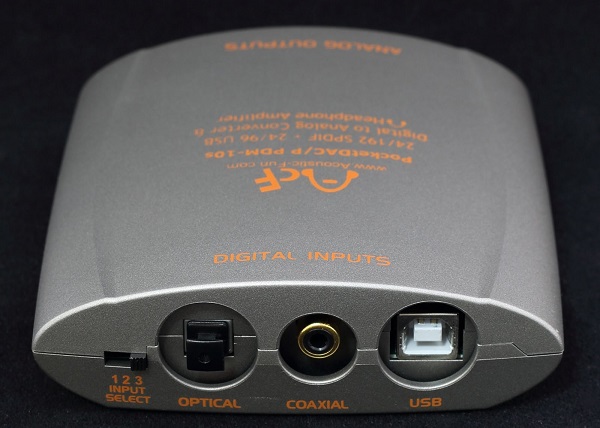
Occasionally, during this continuous burn-in, I used to wear headphones and watch TV. I have never used headphones whilst watching TV before and I quiet enjoyed the experience. On one such occasion, I stumbled upon the movie – The Gladiator on Star Movies HD. I have seen this movie in a theatre in 2000 and more recently on Blu-ray too, but watching the movie with the Panasonic RP-HC700 headphones and AF Pocket DAC connected to the Tata Sky HD Set-Top box was an extremely intimate experience that took me right in the middle of the story. It highlighted a lot of details in the soundtrack which I may have never paid attention to before.
After about 250 hours of burn-in, I started all over again. I’m not sure if a long burn-in is a cure for average performance, but with the AF Pocket DAC, it surely worked wonders and it was well worth the effort and patience. I put it through all kinds of sources, digital inputs and music. I also connected the AF Pocket DAC with all the headphones & IEMs that I had at hand. I’m quite impressed with the improvement the long burn-in has achieved. The most notable improvements were in refinement and bass response which actually impacts the whole presentation.
When Playing FLACs via foobar2000 on my desktop CPU, the USB input is engaged. The same digital USB cable that feeds data also feeds power to the AF Pocket DAC. I connected the Fostex T50RP orthodynamic headphones that are actually quiet hard to scale, to acceptable levels of dynamics, with most average sources. I started by listening to the album Private Investigations – The Best Of Dire Straits, an album I’m familiar with and it gave me an opportunity to understand the AF Pocket DAC’s strengths and weaknesses. In the song – Sultans Of Swing, the low frequencies did not extend as well as what I’m used to listening with my other setups. I replaced the Fostex T50RP headphones with the Panasonic RP-HC700 headphones. The dark and mid-centric presentation was now replaced with a better extended (on both extremes), clearer and brighter (well-lit) presentation with flatter mid-range. The Fostex T50RP headphones offered a fuller and smoother mid-range that suited only vocal performances and for watching TV. The Panasonic RP-HC700 headphones, on the other hand, offered good separation and texture of instruments that suited wider listening applications. The AF Pocket DAC struggled to scale the Fostex T50RP headphones to impressive levels of dynamics and ambient details when connected to the USB input and did a better job at scaling the same headphones when connected to the TOSLINK or S/PDIF input with the external USB wall wart power supply engaged.
The AF Pocket DAC can only handle up to 24bit/96kHz. It does not really matter to me as most of the FLACs that I own are either in 16bit/48kHz resolution or in 24bit/96kHz resolution. So this limitation should matter only to those who already have a collection of audio formats that includes 24bit/192kHz resolution.
Comparisons & Alternatives
The AF Pocket DAC was clearly and audibly better than the headphone output of both my Laptop and desktop CPU. It offered better dynamics, details and control to almost all the headphones and IEMs that I had on hand. I also observed, while searching for DACs online, that the AF Pocket DAC has a striking resemblance to the C2G (Cables To Go) USB DAC listed on Amazon, US and Lindy USB DAC listed on Amazon, UK. Both are Taiwanese made DACs and are priced cheaper than the AF Pocket DAC. A quick exchange of emails with David Wei revealed that the AF Pocket DAC took over 02 years to tweak and it’s more expensive due to the following improvements:
1: The original 3.5mm headphone amp socket was replaced for improved strength and grip.
2: The DAC circuit section was fine tuned.
3: A custom board was added on top of the original board that improved the following:
A: Higher powered RCA output that can drive any pre-amp very well (Original was a passive LPF circuit that sounds quite bad).
B: Higher powered Headphone amp that can output over 135mW per channel and absolutely no explosive clicks, like the original, when powered on or off.
C: Improved high performance, 64 step, volume control. Audio no longer passes through the volume pot, it is all chip controlled and the volume pot will only work as a controller.
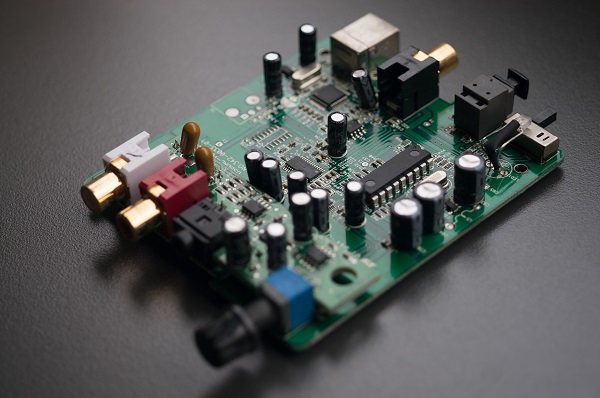
Acoustic-Fun Pocket DAC Vs. Musical Fidelity V-Series II: My desktop system consists of Musical Fidelity (MF) V-DAC II Digital to Analogue Converter connected to a MF V-CAN II Headphone Amplifier and both devices are powered with a MF V-PSU II Linear Power Supply. They also have some good quality DIY interconnects, Silver USB cable, DC link cable, power cord and it’s further fine-tuned with a 1.0A T (Time Delay) aftermarket fuse. The total cost of the MF V-Series desktop set-up is about 10 times the cost of that of the AF Pocket DAC. There are 02 major differences between both the setups: the AF Pocket DAC has a Synchronous USB input whereas, MF V-DAC II has an Asynchronous USB input and the other difference is the quality of power supply. The AF Pocket DAC feeds off the USB power when connected to the USB port of the PC or it can be used with the included external wall wart when the TOSLINK or S/PDIF inputs are engaged. The MF V-Series clearly benefits from MF V-PSU II, an external 12V/0.5A linear power supply, even when the USB input of MF V-DAC II is engaged.
Crap in, crap out! That’s exactly what happens to the performance of most DACs. A lot of people buy DACs to improve MP3 playback, but the truth is – most DACs perform at their best with lossless audio formats such as FLACs and not with compressed audio formats such as MP3s. When playing FLACs, the performance difference between the AF Pocket DAC and MF V-Series comes down to the way they present music. The MF gear offers a laidback and euphoric presentation. The focus is on full bodied mid-range and boomier bass. It also has more volume to drive full-sized and challenging headphones. The AF Pocket DAC, on the other hand, has a lighter and more agile presentation. The overall tone is fairly uncoloured and has decent treble energy. Bass response is very headphone dependant, it shows up a little more effortlessly with efficient headphones.
When watching internet videos, the difference between both setups becomes more apparent. The MF V-Series clearly has a blacker background and is more full-bodied, legible and effortless. The MF V-Series also picks up hall ambience and feedback from high quality videos more effortlessly. This could be due to the implementation of Asynchronous USB input and the external linear power supply – MF V-PSU II, that is used to feed both the MF V-DAC II and MF V-CAN II.
The volume control knob on the MF V-CAN II and the AF Pocket DAC are fairly stiff, they have a good feel and resistance to the touch. They do not turn about or rotate on their axis, easily, even if you happen to mildly touch or push them. There is a tiny dot on both the volume control knobs for easy indication of the volume at use. When there is no music being played, the volume control knob on the AF Pocket DAC does induce mild crackling noise, every time, the volume is increased or decreased. This volume control induced crackling noise in the AF Pocket DAC, however, does not persist when the music is being played. Also, the AF Pocket DAC, at maximum volume, exhibits a mild hissing sound, which again is obvious only when there is no music being played. The MF V-Series setup, on the other hand, is dead quiet regardless of the situation. The MF V-Series setup is so quiet that it’s hard to even know whether they are on or off, thankfully, their soul piercing blue LED lights just gives it away!
In general and for most practical applications, the Fostex T50RP headphones paired better with the Musical Fidelity V-Series setup and the Panasonic RP-HC700 headphones paired better with the Acoustic-Fun Pocket DAC. Both combinations have their own strengths and weaknesses, and as such, regardless of price points, most headphones, amps and DACs will never have all-rounder capabilities. In my experience, a poorly matched pair of equipment can sound uninvolving and unexciting. For this reason, mixing and matching experiments are the only way to establish ideal equipment pairing, in different situations or setups, that one can satisfactorily live with.
I also tried 02 IEMs that I had on hand – the HifiMAN RE-400 and Rock It Sounds R-50M. I tried them with both the above mentioned setups, with various types of music. The HiFiMAN RE-400 IEM paired better with the MF V-Series and offered a very warm and musical presentation. The Rock It Sounds R-50M IEM paired better with the AF Pocket DAC and offered a detailed and insightful presentation.
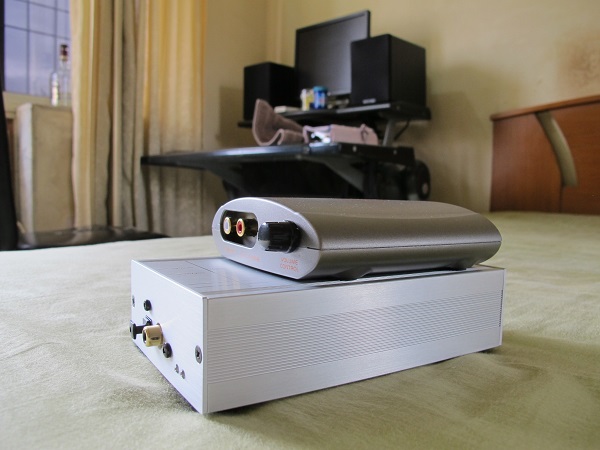
Accessories & Tweaks
The Acoustic-Fun Pocket DAC comes with a 1 meter long USB A-Male to B-Male cable and a USB wall wart 5V/1A power supply. For this review, I mostly used the stock USB cable that came bundled with the AF Pocket DAC. It’s unlikely that anyone would spend USD 100 for an aftermarket USB cable for use with a USD 120 DAC. So I tested this DAC, exactly how its target audience would practically use it, with its stock USB cable.
At one point, out of audiophile curiosity, I connected a Musical Fidelity V-LINK II Asynchronous USB to TOSLINK converter with the help of a Pangea Audio pure silver USB-AG cable and a WireWorld Supernova 6 glass fiber optic TOSLINK. These expensive accessories did bridge the gap between the AF Pocket DAC and the MF V-Series really well, to an extent where the AF Pocket DAC had a well balanced and agile presentation. The background was blacker, cleaner and more refined. The overall sound was much smoother and cohesive. But then again, the combined worth of the AF Pocket DAC and the above accessories are north of USD 500 (equivalent of INR 31250). At that price point, there are plenty of more robust USB DACs to choose from. They were also a clunky setup with the multiple boxes and cables, just like the MF V-Series setup, and are ideal for a dedicated desktop than for a portable setup.
I also tried the Acoustic-Fun C75X Coaxial Digital (S/PDIF) cable and the Acoustic-Fun SIO Glass Multi-fiber Optical Digital (TOSLINK) cable with the AF Pocket DAC during various stages of this review. I also took the time to view the AF SIO glass multi-fiber TOSLINK and WireWorld Supernova 6 TOSLINK under a magnifying glass. The brass tip, holding the lens, on the WireWorld Supernova 6 TOSLINK is flawlessly machine terminated, but then again, it is also priced accordingly – like finely crafted audio jewellery. I actually prefer the AF TOSLINK cable over the AF S/PDIF cable. I found them to be very good value and an ideal match to the fit, build, styling and pricing of the AF Pocket DAC.
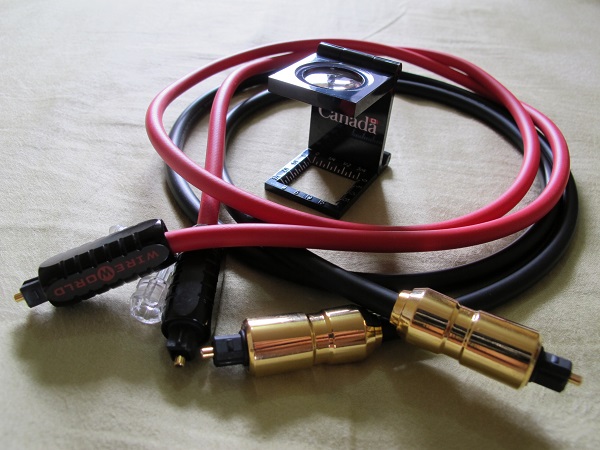
Ending Words
I finally found an affordable and compact solution in the Acoustic-Fun PDM-10s Pocket DAC that allows me to enjoy some good music, on my Laptop with my headphones, when I’m mobile. It’s multi-functional and its compact size allows me to connect it to watch TV too, in private, in decent fidelity via headphones. This is a habit that I discovered and developed during this review.
The AF Pocket DAC can also be used as a Zone 2 or a Zone 3 stand-alone DAC with the help of the supplied external USB wall wart power supply or as a budget desktop setup where it can play the role of a USB DAC, headphone-amp and pre-amp. It also responds well to after-market tweaks. The best tweaks that I can think of and suggest are – a decent quality aftermarket USB cable and a low noise USB power supply, depending on the budget and what one is trying to achieve with this DAC.
The AF Pocket DAC may not be a giant killer but what it offers is good value, decent performance and multi-functionality for the money.
Pros
- A good percentage of the money has been spent where it matters the most – tonally neutral sound quality.
- Compact, lightweight and multifunctional.
- Includes the most commonly used digital inputs – TOSLINK, S/PDIF and USB, all packed in a compact form factor.
Cons
- Excruciatingly long burn-in period of over 250 hours before the sound actually settles down for good.
- The Champagne Gold colour makes the AF Pocket DAC look plasticky.
- May not scale full-sized headphones to satisfactory levels of dynamics and ambient details when USB input is engaged.
For more information on Acoustic-Fun please click on this – LINK.
